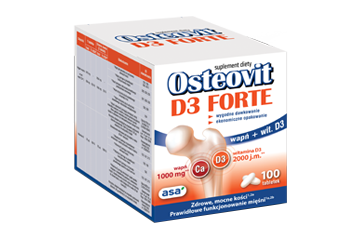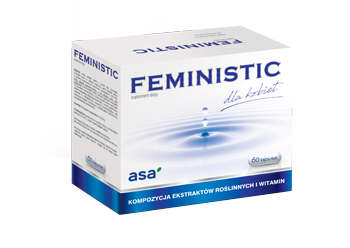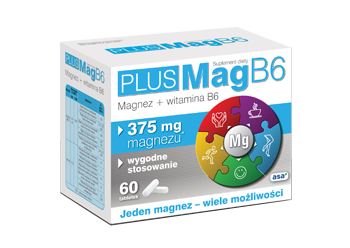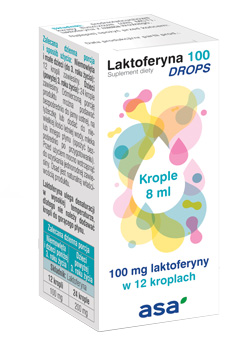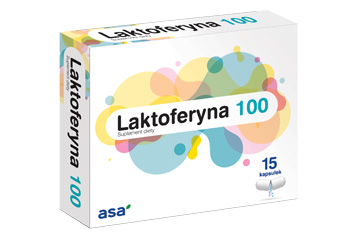Osteovit D3 Forte contains calcium carbonate, which is a source of ionised calcium (Ca2+). Calcium is involved in bone formation and mineralisation1. Contributes to normal muscle function1a. Contributes to normal neurotransmission1b, to normal blood clotting1c. Calcium is part of the body’s electrolyte balance. Calcium contributes to normal energy-yielding metabolism1d by influencing the activity of many enzymes of metabolic pathways.
Vitamin D contributes to normal calcium absorption and to its normal blood levels2.2c. It contributes to the maintenance of normal bones2a and to normal muscle function in our body2b.
For whom is Osteovit D3 Forte recommended? Osteovit D3 Forte is recommended for:
- peri-menopausal women. Calcium and vitamin D help to reduce the loss of bone mineral in women aged 50 years and older during the
postmenopausal period3; - Supportive for the maintenance of normal bones;
- individuals of both sexes aged 60 years and older2d due to increased vitamin D requirements;
- people with long-term disabilities;
- for supplementing vitamin D3 and calcium deficiencies in the body.
INGREDIENTS: calcium carbonate; bulking agent: microcrystalline cellulose, cellulose gel; cholecalciferol (vitamin D);
anti-caking agent: magnesium salts of fatty acids; binders: hydroxypropyl methyl cellulose,
Polyvinyl alcohol (PVA); thickener: cross-linked carboxymethylcellulose sodium, cross-linked cellulose gum.
Reference intake: 2 times a day 1 tablet, with a small amount of liquid. It is recommended to take the preparation with a meal due to better absorption of the active substances.
Information on the product’s minimum expiration date expressed with the words: “Best before end” can be found on the bottom flap of the packaging.
Storage: Keep in a dry place at room temperature (15-25°C).
Content: 100 tablets, net weight: 154.4 g
Caution: Do not exceed the daily reference intake. Dietary supplements must not be used as a substitute (replacement) for a varied diet or a healthy lifestyle. It is important to remember that a balanced diet and a healthy lifestyle are important. The preparation should be kept out of the reach and sight of small children. The product is intended for healthy adults up to 75 years of age. There are many risk factors for bone fractures2d,3. Changing one of these risk factors may or may not have a beneficial effect.
Information for celiac disease patients: gluten-free preparation.
Lactose-free. It can be used by diabetics.
| Reference intake
(2 tablets) |
Claim | Claim ID | ||
| Quantity | % RI* | |||
| Calcium carbonate
of which: calcium (Ca2+) |
2950 mg
1000 mg |
–
125 % |
1Calcium is needed for the maintenance of normal bones | 224, 230,350, 4311 |
| 1aCalcium contributes to normal muscle function | 226, 230, 235 | |||
| 1bCalcium contributes to normal neurotransmission | 227, 230, 235 | |||
| 1cCalcium contributes to normal blood clotting | 230, 236 | |||
| 1dCalcium contributes to normal energy-yielding metabolism | 234 | |||
| 3Calcium and vitamin D help to reduce the loss of bone mineral in post-menopausal women. Low bone mineral density is a risk factor for osteoporotic bone fractures.
The beneficial effect is obtained with a daily intake of at least 1 200 mg of calcium and 20 µg of vitamin D from all sources. The claim is specifically intended for women 50 years and older. |
EFSA Opinion No.: Q-2008-721, Q-2009-00940 Claim from Article 14(1) (a) Reg. 1924/ 2006 Commission Regulation (EU) No 1228/2014 |
|||
| Vitamin D
(cholecalciferol) |
50 μg | 1000 % | ||
| 2Vitamin D contributes to normal absorption/utilisation of calcium and phosphorus | 152, 157, 215 | |||
| 2aVitamin D contributes to the maintenance of normal bones | 150, 158 | |||
| 2bVitamin D contributes to the maintenance of normal muscle function | 155 | |||
| 2cVitamin D contributes to normal blood calcium levels | 152, 157, 215 | |||
| 2dVitamin D helps to reduce the risk of falling associated with postural instability and muscle weakness Falling is a risk factor for bone fractures among men and women 60 years of age and older
The beneficial effect is obtained with a daily intake of 20 μg of vitamin D from all sources. |
EFSA Opinion No.: Q-2010-01233
Claim of Article 14(1) (a) Reg.1924/ 2006 Commission Regulation (EU) No. 1228/2014 |
|||
*RI – Reference Intakes
